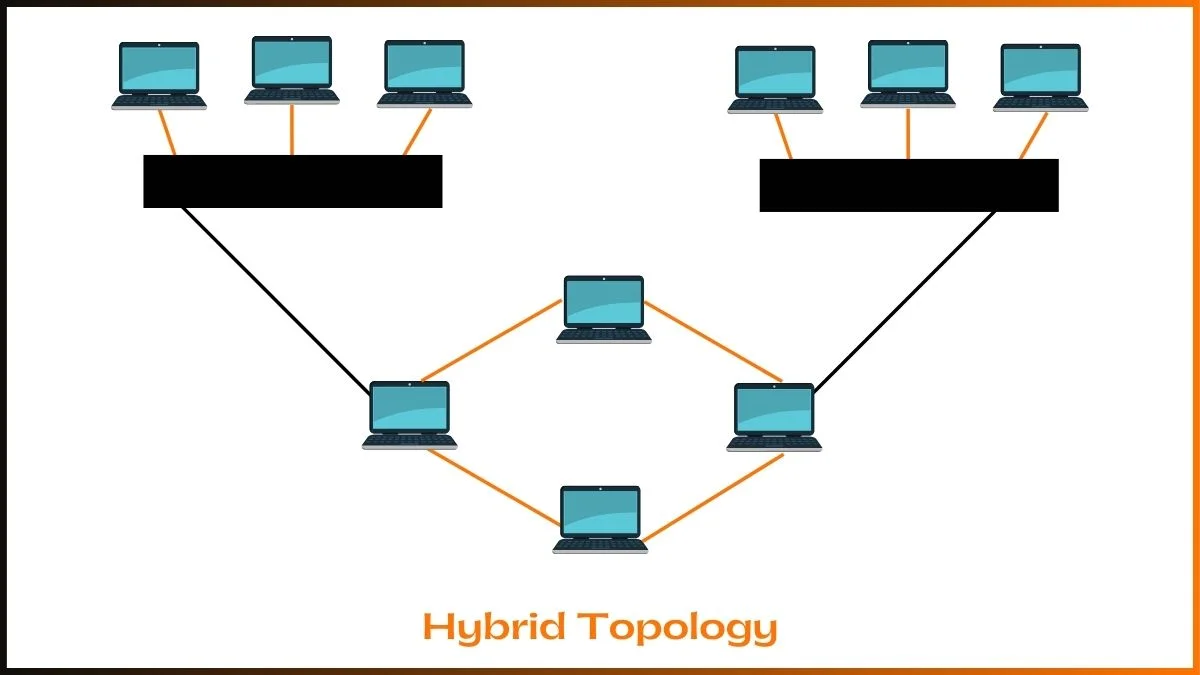10 Uses of Hybrid Topology
Hybrid topology is used in many places, such as schools, offices, banks, airports, e-commerce companies, governments, hospitals, ISPs, shopping malls, and smart homes. It is due to because it is flexible and reliable. It combines different topologies to create a network that meets specific needs. Below, we will look at uses of hybrid topology in detail.
Uses of Hybrid Topology in Networking
Here are the common uses of hybrid topology in daily life:

1. Schools and Universities
Schools and universities use hybrid topology to connect computer labs, classrooms, and administrative offices. Each classroom may use a star topology, where all computers connect to a central hub.
These classrooms then connect to the main network using a bus topology. This setup makes it easy to manage the network and add new classrooms or devices.
2. Offices and Corporate Networks
Offices use hybrid topology to connect different departments like finance, sales, and HR. For example, the finance department may use a star topology for secure connections. While the sales department uses a ring topology for fast data transfer.
These departments connect to form a hybrid network. This setup helps offices manage large networks efficiently.
3. Banking Systems
Banks use hybrid topology to ensure secure and reliable transactions. Critical servers that handle customer data can use a mesh topology for high security. Other devices, like employee computers, use a star topology. This combination keeps the network secure and ensures that transactions are processed quickly.
4. Airports and Railway Stations
Airports and railway stations use a hybrid topology to handle large networks. Ticket counters, security systems, and passenger Wi-Fi all need to work together. Ticket counters may use a star topology, while security systems use a bus topology.
This setup ensures that all systems work smoothly. Also, during peak hours.
5. E-commerce Companies
E-commerce companies use hybrid topology to manage customer and business data. Website servers may use a mesh topology for high reliability, while employee computers use a star topology. This setup ensures that online shopping websites are always available and fast.
6. Government and Military Networks
Governments and military organizations use hybrid topology for secure communication. Military bases may use a mix of star and mesh topologies. Critical systems, like communication devices, use a mesh topology for high security.
Other systems, like office computers, use a star topology. This setup keeps sensitive information safe.
7. Hospitals
Hospitals use hybrid topology to connect medical devices and computers. Patient monitoring systems may use a star topology, while hospital servers use a bus topology. This setup ensures that patient data is always available and secure. It also helps doctors and nurses access information quickly.
8. Internet Service Providers (ISPs)
ISPs use hybrid topology to provide Internet to homes and businesses. The main servers may use a tree topology, while local connections use a star topology. This setup helps ISPs manage large networks with many users. It also ensures that internet connections are fast and reliable.
9. Shopping Malls
Shopping malls use hybrid topology to connect security cameras, Wi-Fi, and point-of-sale systems. Security cameras may use a ring topology, while Wi-Fi and point-of-sale systems use a star topology. This setup ensures that all systems work together smoothly. It also helps mall managers monitor the premises easily.
10. Smart Homes
Smart homes use a hybrid topology to connect devices like smart lights, security systems, and thermostats. Smart lights may use a star topology, while security systems use a bus topology. This setup ensures that all devices work together efficiently. It also makes it easy to add new devices to the network.
Why is Hybrid Topology Popular?
Hybrid topology is popular because it is flexible, reliable, and scalable. It combines the strengths of different topologies to create a network that meets specific needs.
For example, it can handle large networks, provide high security, and ensure fast data transfer. This makes it a good choice for schools, offices, banks, airports, e-commerce, government, hospitals, ISPs, shopping malls, and smart homes.







Leave a Reply